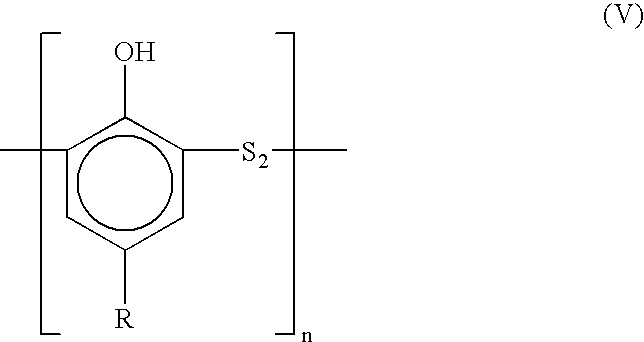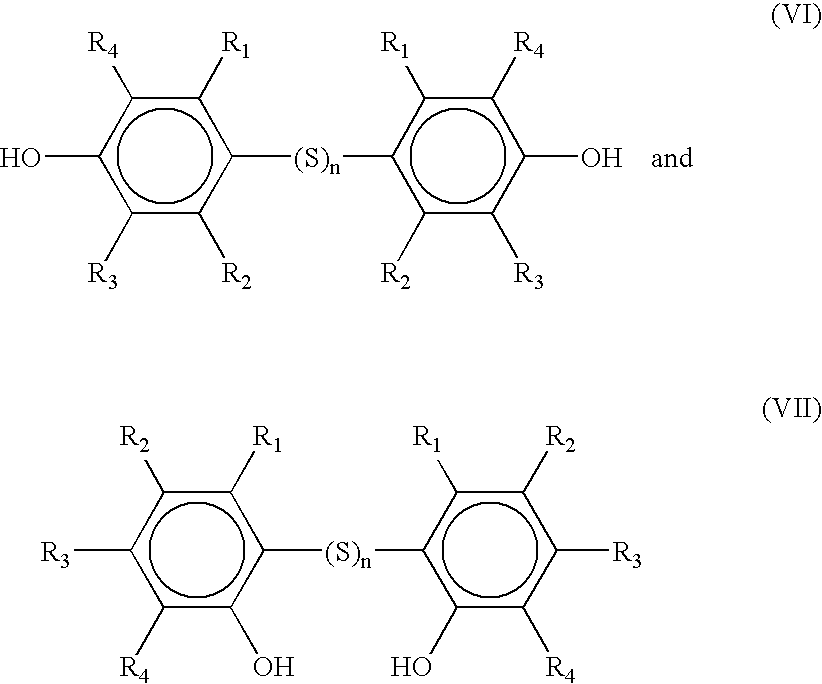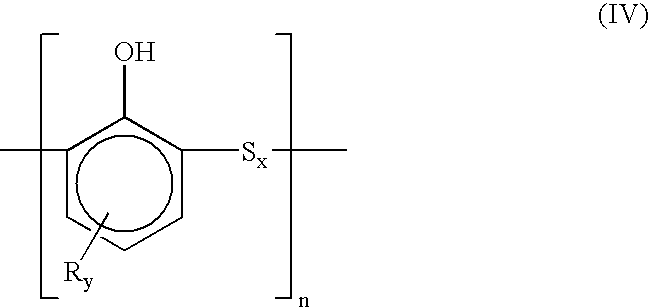Dimeric and polymeric alkylphenol polysulfides
a technology of dimeric alkylphenol and polymer alkylphenol, which is applied in the field of preparation of dimeric and polymeric alkylphenol polysulfides, can solve the problems of large dose of n-nitrosoamine, unusable products, and formation of porous vulcanizates, and achieve similar, if not superior properties
- Summary
- Abstract
- Description
- Claims
- Application Information
AI Technical Summary
Benefits of technology
Problems solved by technology
Method used
Image
Examples
example # 1
EXAMPLE #1
[0033]Table I gives the typical preparation of bis-p-cumylphenol disulfide of formula (II) using toluene or xylene as the solvent
[0034]
TABLE I(II)Starting MaterialsM.W.MolesWt. (g)Wt. %% Sp-cumylphenol2120.337161.2—S2Cl2 (sulfur monochloride)1350.334538.847.4
The following steps were employed. A clean and dry 3-neck flask was equipped with a graduated dropping funnel and a Dean-Stark head. P-cumylphenol was charged as a liquid or solid into the flask, followed by toluene or xylene as the solvent and the mixture agitated. Sulfur monochloride was charged into the dropping funnel with a transfer needle-line under nitrogen followed by dropwise addition of S2C2. During the exothermic addition, the reaction temperature increased to 25° C. from 20° C. when the addition was complete. Further heating raised the reaction temperature to 86° C. This temperature, between (80° C.-86° C.) was maintained for about 2 hours. The reaction was allowed to start to cool under a nitrogen blanket ...
example # 2
EXAMPLE #2
[0041]A comparative study in EPDM (ethylene propylene diene monomer) is illustrated in Table III. EPDM was compounded with carbon black and oil. The cure system employed thiozole sulfenamide, sulfur and either alkyphenol or alkylaryl phenol disulfide polymer. The alkylphenol disulfide or the alkylaryl phenol disulfide were used at 2 phr (parts per hundred parts rubber) for those compounds which contained stearic acid and at 1.88 phr for those without stearic acid with results as shown in Table III
[0042]
TABLE IIIRheometer 350° F.Vultac ™ 710Formula (II)Formula (III)Max. torque10.959.7111.22Tc(10) (min.)a0.840.790.86Tc(50) (min.)b1.61.51.6Scorch time - Ts21.031.031.07(min.)a= time to 10% torque increaseb= time to 50% torque increase
example # 3
EXAMPLE #3
[0043]A comparative study was performed in Styrene Butadiene Rubber (SBR). A masterbatch was prepared containing 100 phr rubber / 62.5 phr aromatic oil and 82.5 phr N339 carbon black as shown in Table IV with results in Table V.
[0044]
TABLE IVFormulaphrSBR 1848245.00Stearic acid2.00Zinc oxide3.00Sulfur1.50TBBS accelerator1.50(N-Tertiarybutyl-2-benzothiazolesulfonamide)Alkyl or alkylarylphenol disulfide2.00 (stearic acid)polymeror 1.88 (no stearic acid
[0045]
TABLE VRheometer 350° F.Vultac 710Formula IIFormula IIIMax. torque / in.-lb.9.238.389.32Tc(10) (min.)a1.341.471.27Tc(50) (min.)b2.22.442.13Scorch time - Ts21.681.941.6(min.)a= time to 10% torque increaseb= time to 50% torque increase
[0046]The data above shows that Formula II matches or exceeds the performance of Vultac™ 710.
[0047]Para-cumylphenol can be used to produce alkylarylphenol disulfide polymers having good properties in regard to curing rubber compounds and they are less volatile and have excellent compatibility with...
PUM
| Property | Measurement | Unit |
|---|---|---|
| reaction temperature | aaaaa | aaaaa |
| reaction temperature | aaaaa | aaaaa |
| temperature | aaaaa | aaaaa |
Abstract
Description
Claims
Application Information
 Login to View More
Login to View More - R&D
- Intellectual Property
- Life Sciences
- Materials
- Tech Scout
- Unparalleled Data Quality
- Higher Quality Content
- 60% Fewer Hallucinations
Browse by: Latest US Patents, China's latest patents, Technical Efficacy Thesaurus, Application Domain, Technology Topic, Popular Technical Reports.
© 2025 PatSnap. All rights reserved.Legal|Privacy policy|Modern Slavery Act Transparency Statement|Sitemap|About US| Contact US: help@patsnap.com



